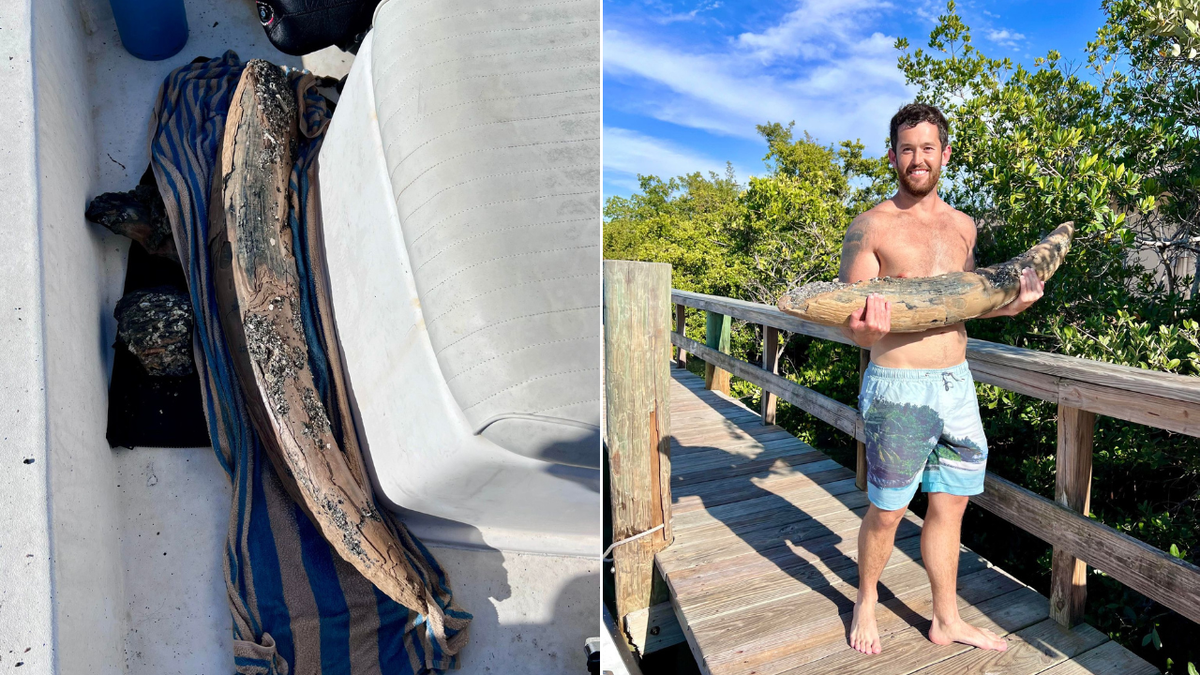A Florida man recently found a prehistoric jackpot while diving off the Sunshine State’s coast.
Lundberg, who studied marine biology at the University of South Florida, told Fox News Digital that he found an ancient mastodon tusk while scavenging for fossils off Manasota Key, which is around 90 miles south of Tampa. He found the relic back in April.
The mastodon tusk, which has not been dated, could be millions of years old. While the 29-year-old said he’s been scuba diving for 12 years, Lundberg has been a fossil hunter since he was “old enough to walk.”
“My dad would take us out to construction sites all the time to look for fossils as a kid,” Lundberg explained.
WOMAN OUT FOR WALK STUMBLES UPON ONCE-IN-A-DECADE DISCOVERY

Lundberg, who studied marine biology at the University of South Florida, found the tusk back in April. (Alex Lundberg)
“Finding small pieces and chunks of tusk is common, but finding one this large and well-preserved is very rare,” the scavenger added. “Tusks found in Florida are normally very delicate and usually crumble apart.”
American Mastodons went extinct around 10,500 years ago, according to the National Park Service (NPS). The fossils of the massive creatures have been found across North America and Central America, from Alaska to Mexico.
Contrary to popular belief, mastodons are not the same species as mammoths, though they did share a common ancestor with mammoths and elephants. The creatures could grow as high as 10 feet tall.
MICHIGAN RESEARCHERS DISCOVER EERIE 1909 SHIPWRECK AT BOTTOM OF LAKE SUPERIOR

Lundberg describes himself as a life-long fossil hunter. (Alex Lundberg)
“Although the mastodon has been around since [4 to 3 million years ago], mammoths didn’t arrive in North America until much later, during the Pleistocene ice ages,” the NPS’s website reads. The Pleistocene epoch stretches from 2.6 million years ago to 11,700 years ago.
“Mastodons did co-exist in many places with mammoths, but all of North America’s proboscideans went extinct by around 10,500 years ago,” the NPS added.
Lundberg advises that aspiring fossil hunters should remember to get a fossil permit, if they’re lucky enough to find a prehistoric object. He said the state of Florida’s fossil permits only cost five dollars each.
CLICK HERE TO SIGN UP FOR OUR LIFESTYLE NEWSLETTER

Lunberg says that it is rare to find a well-preserved, intact mastodon tusk off Florida waters. (Alex Lundberg)
“My best tip is to get out and explore and keep your head down,” he said. “This stuff is out there and all over the state.”
As to where the ancient mastodon tusk will go next, Lundberg said that he will keep it unless experts deem it important enough to donate.
“I plan on keeping it, but I do have to report it at the end of the year to the Florida Museum of Natural History,” he said. “If they deem it scientifically important, I have to donate it, but that is very unlikely.”

The mammoth tusk will be donated to a natural history museum if deemed scientifically significant. (Alex Lundberg)
CLICK HERE FOR THE FOX NEWS APP
Fox News Digital reached out to Florida Museum of Natural History for comment, but experts were not able to comment at the time of publication.
For more Lifestyle articles, visit www.foxnews.com/lifestyle.



